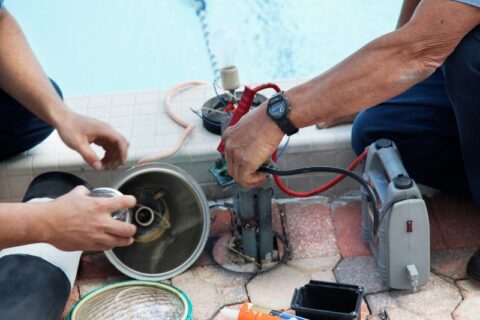The Pool Painting Procedure
How to Paint a Pool
If you own a pool, you know that it requires plenty of maintenance. No matter how diligently you tend it, though, there may be a time when the pool needs repainting. Are you planning to handle this chore yourself? The pool painting procedure can be a challenge, especially if you’ve never tackled this kind of job before. Here, we’ll explain the process of painting a pool, along with some reasons why you might want to call in the experts for this task.
Steps to Paint a Pool
- Time your project with the right weather conditions. To paint a pool, you need a stretch of time no shorter than one week, and preferably longer. The tricky part is timing this to go along with the weather, because you will need a span of time with absolutely no rain and at least a few hours of sun each day. Don’t paint your pool when the temperature is above 90°F, below 40°F, or extremely humid, and don’t paint when it’s windy, because leaves and debris blown into your pool can ruin the paint job. Don’t drain your pool right before or after a large storm, because when the water table is high, there is a risk that it can “float” the pool, displacing it from the ground.
- Determine the type of paint you need to use. To figure this out, you’ll need to find out what kind of paint was previously used on your pool. If your pool was previously painted with Epoxy pool paint, you can’t paint over it with Chlorinated Rubber pool paint, and the same is true in reverse. In order to determine the kind of paint that has been used on your pool, clean a dry patch on the pool surface, apply acetone to a rag and rub the painted surface for 30 seconds, then touch the surface. If it’s sticky, it’s a chlorinated rubber coating, but if not, it’s an Epoxy coating. Once you know which paint to use, you can use a pool painting calculator to determine how much paint you need for your particular pool surface.
- Prep the surface of the pool. Of course, you’ll need to drain it first, removing debris and any hydrostatic plugs. Next, scrape away loose paint, fill any cracks or hollow spots, and repair any other damage to the surface. Once that is completed, you will need to rinse and scrub with Tri-Sodium Phosphate (TSP) to remove oil, then acid wash the surfaces to roughen them. This can be a hazardous process, involving diluted muriatic acid, a watering can, and a garden hose, to allow you to quickly rinse the acid. Rinse the pool thoroughly to remove any acid or TSP that remains, and allow the pool to dry completely, probably for three to five days. Once it’s totally dry, you’ll need to make sure there are no paint flakes, leaves, dirt, or debris on the surface, then tape up the lights, tiles, and fittings with painter’s tape. Now you’re ready to start painting.
- Apply the first coat of paint. Following the manufacturer’s instructions for using the paint, try and get the entire pool painted in one day. It must then be allowed to cure for 24 hours before you apply the next coat. Start at the deep end and work your way to the shallow end, using a telescoping paint pole to reach all the edges of the pool.
- Move on to the second coat of paint. You should strive to paint the second coat 24 hours after the first coat. If you wait longer than that, you will need to abrade the pool surface again before applying a new coat.
- Let your pool dry completely. This takes a minimum of three to five days, but it’s better to wait at least seven days in summer or 14 days in winter before putting water back into your pool. If you refill the pool before it’s had time to dry thoroughly, you risk discoloring it.
- Fill the pool. Once your pool is ready to be filled, run the water to fill it without stopping. Wait three to five days to add chemicals, then balance the pH, alkalinity, and hardness. Start up the filter system, add chlorine tablets, and resume your normal chemical maintenance.
Why Call a Swimming Pool Painting Company?
If you took the time to read all this, the answer to this question is probably pretty apparent already. Painting a pool is a huge job for a homeowner, time-consuming, expensive, labor-intensive, and complicated. Hiring a pool painting company means enlisting the help of professionals, who can get the job done quickly and efficiently, so you can get back to enjoying your pool.
Call in the Professionals to Get the Job Done Right
If you are looking for a swimming pool company that provides a wide array of pool services, including pool painting, you can’t go wrong with Millennium Pool Services. With over 30 combined years of experience in the pool industry, we provide a comprehensive range of pool services for both residential and commercial customers in Virginia, Washington DC, and Maryland. When you hire Millennium Pool Service, you get a well-qualified, industry-trained staff of pool contractors and technicians, services that are tailored to your needs, and a commitment to 100% customer satisfaction. Contact us for more information.

